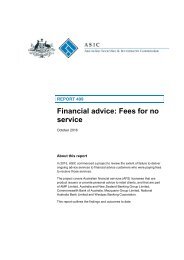statistics
2g0RSM6
2g0RSM6
Create successful ePaper yourself
Turn your PDF publications into a flip-book with our unique Google optimized e-Paper software.
Explanatory notes<br />
Introduction<br />
This publication includes data across different reporting frameworks. For more detail see Change in<br />
reporting frameworks in this note.<br />
The database version of this publication includes a full time series of <strong>statistics</strong> that are published in<br />
the PDF and Excel versions, and also contains additional data items including operating income and<br />
expenses, solvency, and more class of business <strong>statistics</strong>. Calculated ratios are not provided in the<br />
database version of the publication. A list of ratios and their calculation methodology is provided in the<br />
Data dictionary in the database version.<br />
In the database version, industry data are not provided where direct insurer and reinsurer data are<br />
provided. The industry figure can be calculated by summing these sectors. This principle also applies<br />
to class of business data. Sub-level data may not sum up to total figures due to rounding.<br />
Source of data<br />
Data in this publication are sourced from regulatory returns submitted to APRA under the Financial<br />
Sector (Collection of Data) Act 2001 by authorised general insurance companies. Statistics on Lloyd's<br />
Australian operations are not included in this publication.<br />
Blank copies of the returns and associated instructions are available on the APRA website.<br />
Basis of preparation<br />
Data in this publication are prepared from the individual authorised insurer accounts, not consolidated<br />
insurance group accounts. Transactions between related entities within the same insurance group<br />
have not been eliminated. Examples of such transactions include intra-group reinsurance<br />
arrangements (premiums, claims, reinsurance recoveries, provisions) and loans between parents and<br />
subsidiaries.<br />
Due to the nature of the insurance and reinsurance industry, double counting of claims and premiums<br />
will occur in gross measures. Inwards reinsurance essentially reflects a restatement of premium that<br />
has already been included in the direct business figures (where the business is ceded by Australian<br />
authorised insurers).<br />
Figures represent the total operations of Australian authorised insurers, not only business undertaken<br />
within Australia.<br />
Change in reporting framework<br />
From the September 2010 quarter onwards, data in this publication are prepared based on APRA<br />
reporting which has been largely aligned with AASB 1023 General Insurance Contracts (AASB 1023) .<br />
Data in the publication prior to September 2010 are based on APRA’s ‘prospective accounting’<br />
reporting framework that applied until 1 July 2010. Under this framework, insurers used prospective<br />
liability valuation requirements prescribed by Prudential Standard GPS 310 Audit and Actuarial<br />
Reporting and Valuation (GPS 310) .<br />
Under APRA’s prospective accounting reporting framework, expected future profit or loss on written<br />
business was immediately recognised. Under AASB 1023 , profit or loss is recognised over time in<br />
accordance with the expected pattern of risk associated with the business.<br />
From the March 2013 quarter onwards, capital and solvency data items are reported under APRA’s new<br />
capital standards which were effective from 1 January 2013 onwards.<br />
Australian Prudential Regulation Authority 26



